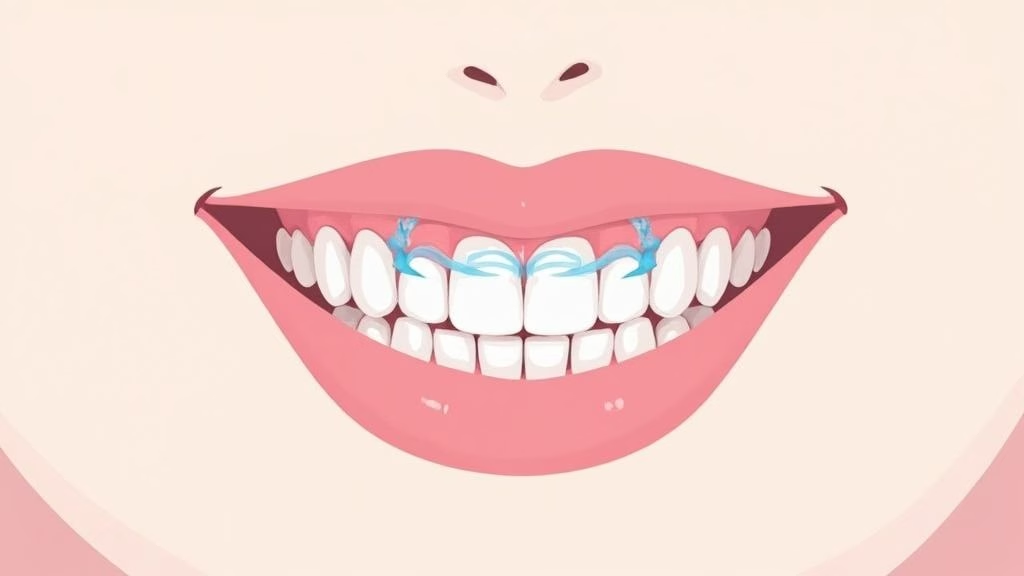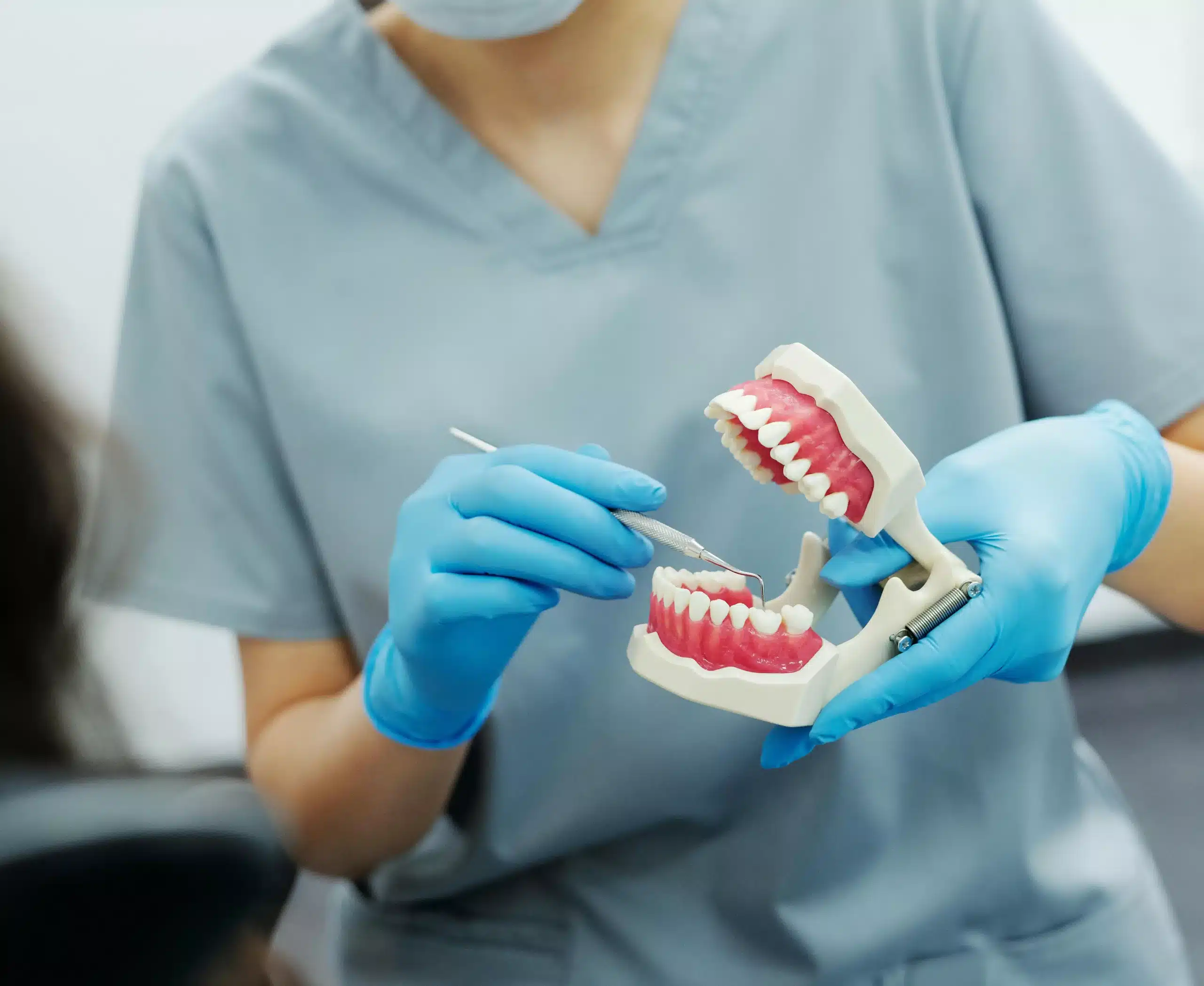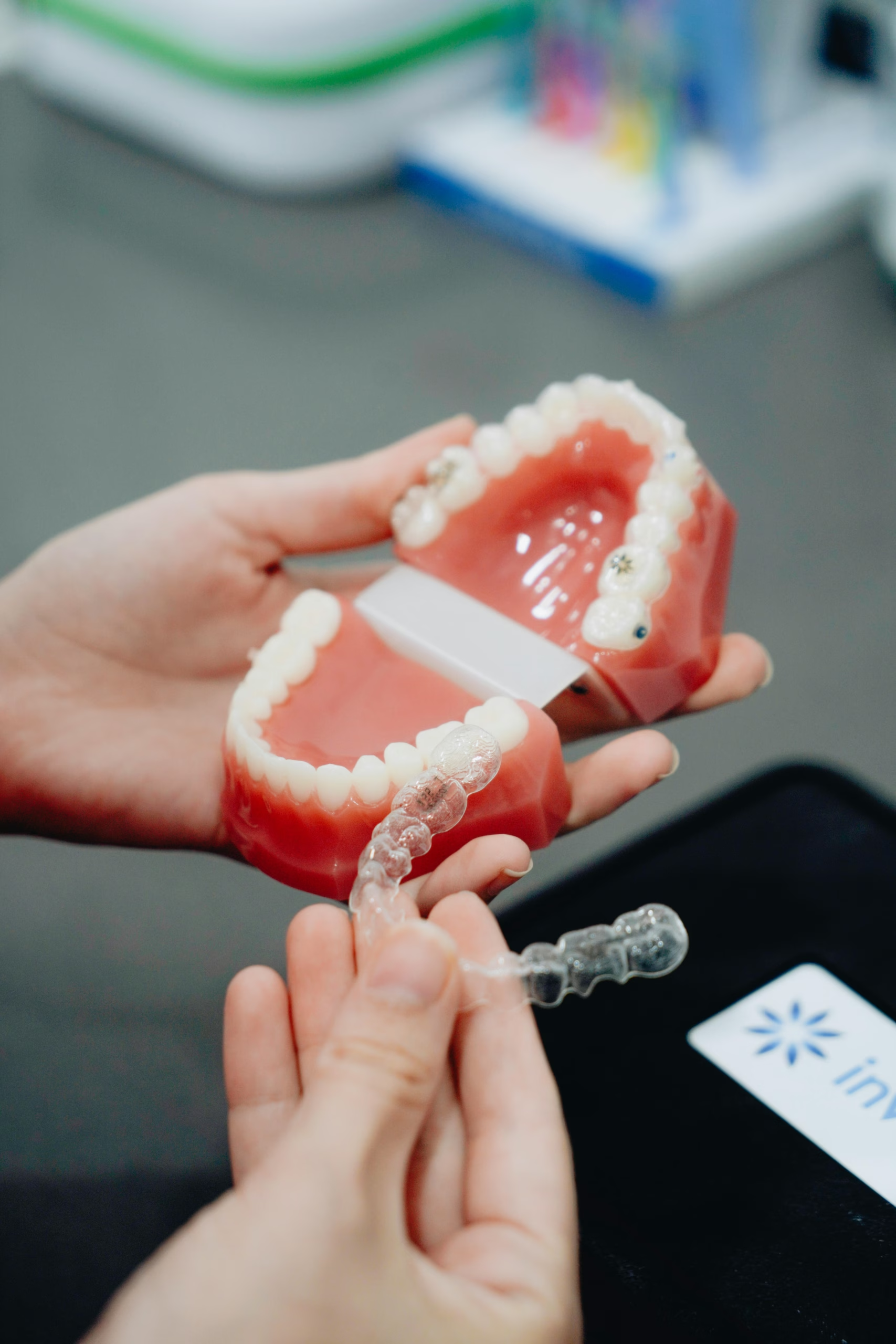Dental Abscess Pain Relief Fast At-Home Soothing Tips
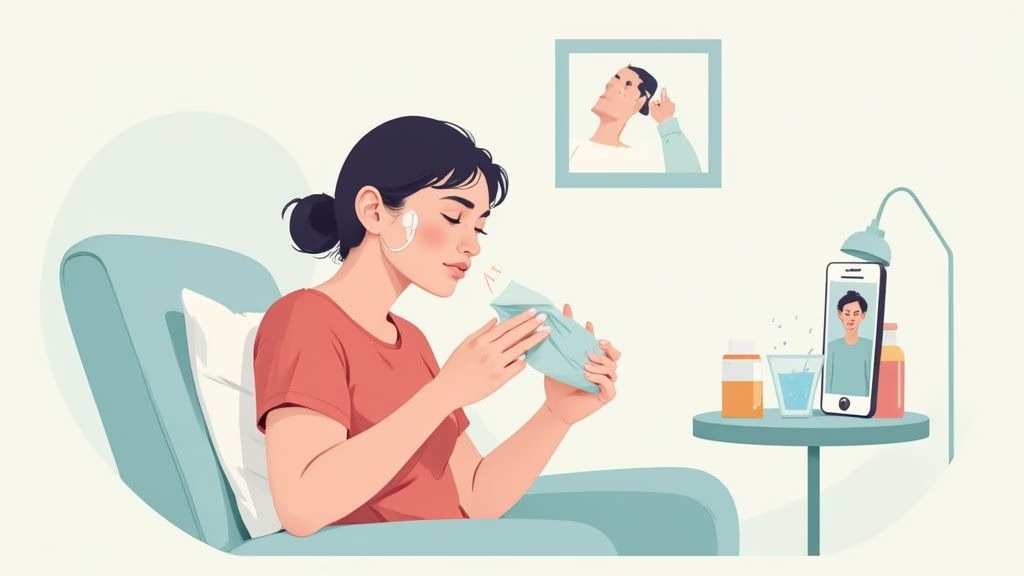
That awful, throbbing pain from a dental abscess isn’t just a bad toothache. It’s a serious warning sign from your body, telling you an infection needs to be dealt with—and fast. The only way to get real dental abscess pain relief is to understand what’s happening: a bacterial infection has formed a pocket of pus, creating intense pressure and misery.
What’s Really Going On in There
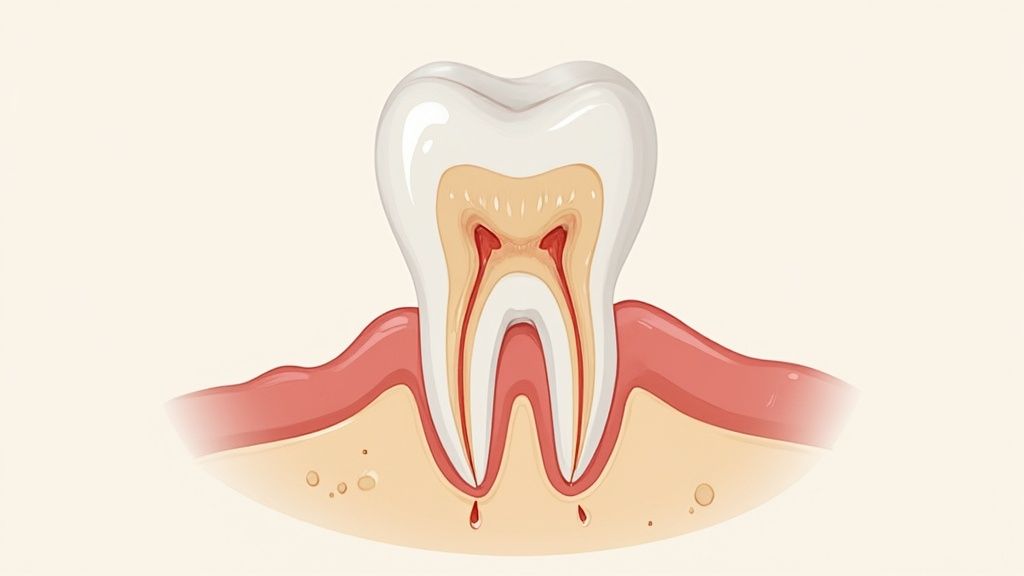
Think of a dental abscess as your body’s emergency response to a bacterial attack. This can be triggered by a deep cavity, a cracked tooth from an injury, or even advanced gum disease. Bacteria sneak into the soft inner part of the tooth (the pulp) or get trapped in the pocket between your tooth and gum.
Your immune system rushes to the scene, sending in white blood cells to fight the invaders. This intense battle creates pus—a lovely mix of dead bacteria, tissue, and white blood cells. With no way to drain, this pocket of pus swells up, pressing hard on the nerves and bone. That’s where the severe, often unbearable pain comes from.
If you want to get into the nitty-gritty, you can delve deeper into what an abscess is for a more detailed breakdown. Getting your head around the problem is the first step towards sorting it out for good.
Gum Abscess vs. Tooth Abscess
It’s also worth knowing that not all abscesses are created equal. Where it’s located changes the symptoms and how a dentist will treat it. Figuring out which one you might have can help you explain things more clearly when you seek help.
- Periapical Abscess (Tooth Abscess): This is the one most people think of. It forms right at the tip of the tooth’s root, usually because a cavity has gone deep enough to infect the pulp. The pain is typically sharp, throbbing, and focused on that one specific tooth.
- Periodontal Abscess (Gum Abscess): This one sets up shop in the gum tissue next to the tooth. It’s often linked to gum disease and makes the gum look red, swollen, and feel incredibly tender to the touch.
Here’s a quick guide to help you figure out what your symptoms might be pointing to.
Dental Abscess Signs and What They Mean
| Symptom | What It Feels Like | Level of Urgency |
|---|---|---|
| Severe, persistent throbbing pain | A constant, pulsing ache that doesn’t go away and might radiate to your jaw, neck, or ear. | High – See a dentist immediately. |
| Swelling in your face or cheek | A noticeable puffiness or lump on the outside of your face near the painful area. | Very High – This could mean the infection is spreading. Seek urgent care. |
| Fever or feeling unwell | You feel generally sick, tired, or have a high temperature along with the tooth pain. | Emergency – Go to A&E or seek immediate dental care. Infection may be systemic. |
| Bad taste or smell in your mouth | A sudden rush of foul-tasting, salty fluid, possibly followed by a temporary relief of pain. | High – The abscess may have ruptured. You still need a dentist to clear the infection. |
While a table can help you self-assess, it’s no substitute for professional advice. Any of these signs mean you need to get in touch with a dental professional right away.
An abscess will not go away on its own. While the pain might temporarily subside if the abscess ruptures and drains, the underlying infection remains active and can spread. Delaying treatment is never a safe option.
Waiting days for an appointment can feel like an eternity when you’re in agony. Thankfully, that’s not your only option anymore. Services like Toothfairy offer a lifeline, giving you on-demand access to a dentist through a video call. You can get an immediate professional assessment, practical advice, and even a prescription for antibiotics if needed, all without the agonising wait. It’s a smarter, more affordable way to handle dental emergencies, cosmetic work, or even straighten your teeth.
Immediate Pain Relief You Can Use at Home
When a dental abscess hits, the pain can be completely overwhelming, and waiting for an appointment can feel like an eternity. While a dentist is the only one who can truly fix the problem, you’re not helpless. There are some safe and practical things you can do right now to get some temporary relief and make the wait more bearable.
One of the first and simplest things I recommend to patients is a saltwater rinse. It might sound like an old wives’ tale, but it genuinely works. The salt helps make your mouth a less friendly place for bacteria and can gently soothe inflamed, angry gums. Just dissolve half a teaspoon of salt in a glass of warm water and swish it around your mouth for about 30 seconds before spitting it out.
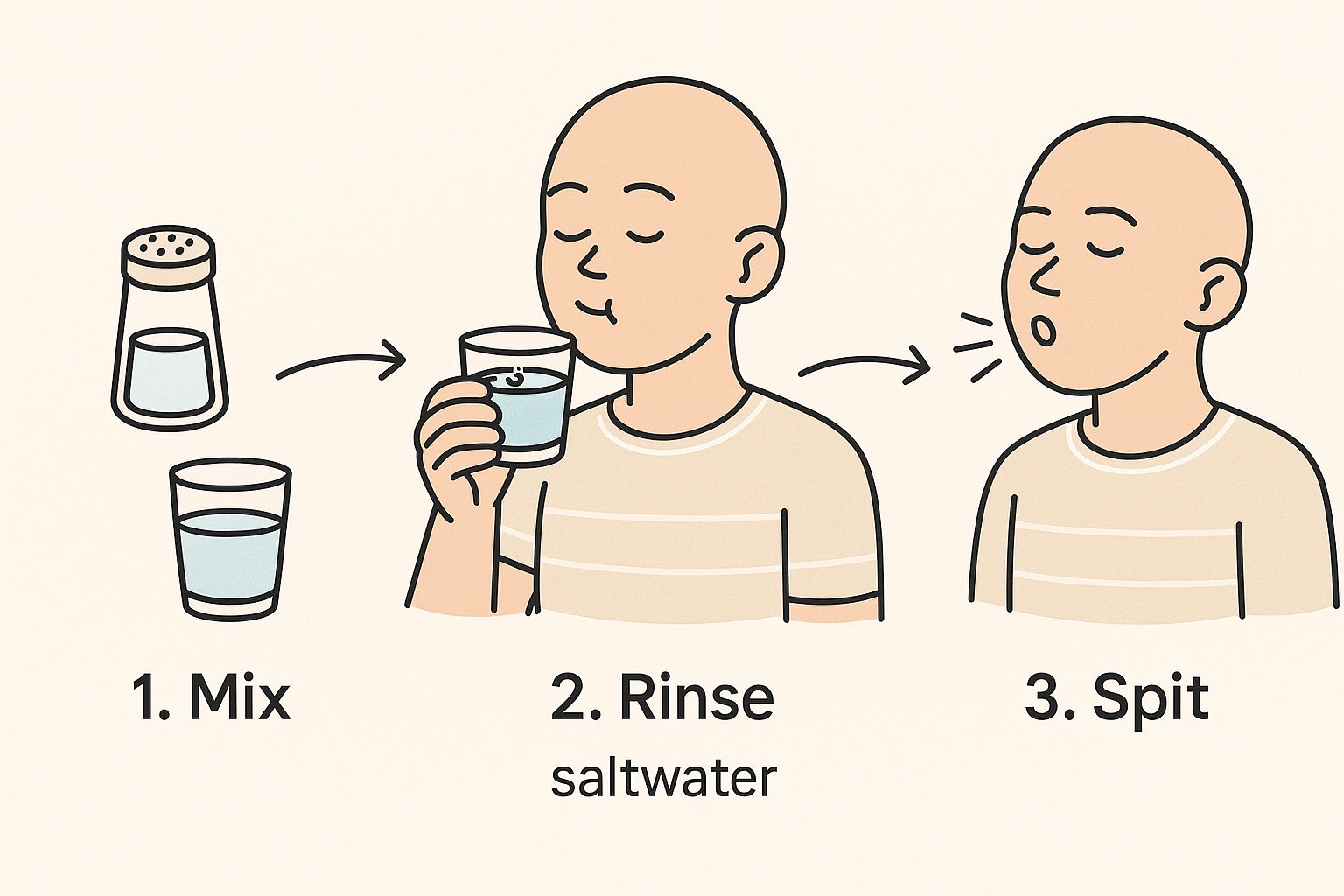
As you can see, it’s an incredibly simple process. By gently rinsing, you’re not only cleaning the area but also helping to draw out some of the fluid that’s causing that awful, throbbing pressure.
Simple Adjustments for Managing Pain
Beyond rinses, a few small tweaks to your daily habits can make a massive difference to your comfort levels. The main goal here is to avoid anything that might irritate that already sensitive tooth.
Think about what you’re eating and drinking. Anything extremely hot, cold, or sugary is likely to send a shooting pain right through the nerve. For now, it’s best to stick to soft, lukewarm foods – think soups, yoghurts, or scrambled eggs. Anything that doesn’t require much chewing is your friend.
Even the way you sleep can have an impact.
Lying flat allows more blood to rush to your head, which can make the throbbing sensation from the abscess much worse. Try propping your head up with an extra pillow or two to elevate it and reduce that intense pressure overnight.
These little changes won’t cure the infection, but they can make life much more manageable while you wait to see a professional.
What You Must Avoid at All Costs
In a moment of desperation, it’s tempting to try anything for relief. But please be careful – some “home remedies” are not only ineffective but can be downright dangerous. The big one to remember is to never place an aspirin tablet directly on your gum or tooth. Aspirin is an acid, and doing this will give you a nasty chemical burn on top of the infection you already have.
Here are a few other absolute no-gos:
- Don’t poke or try to burst the abscess yourself. This is a huge risk. You could easily push the infection deeper into your jaw or even into your bloodstream, turning a local problem into a much more serious, systemic one.
- Avoid using alcohol as a painkiller. Rinsing with whisky or other spirits will only irritate the delicate tissues and offers, at best, a few seconds of distraction.
- Steer clear of hot compresses. While a cold pack can help reduce swelling, applying heat can actually encourage the infection to spread.
Stick to safe, proven methods to manage your pain without causing more harm. And remember, these tips are just to get you through. Getting a professional diagnosis is critical. If you’re struggling to get an appointment, services like Toothfairy offer a brilliant way to get an immediate assessment from a dentist via a video call, giving you expert advice to bridge the gap until you can get hands-on treatment.
Choosing the Right Over-the-Counter Painkillers
Walking into a pharmacy when you’re in agony can feel overwhelming. The shelves are lined with options, and when you’re desperate for dental abscess pain relief, knowing what to grab is crucial. The trick isn’t just to numb the pain but to tackle the inflammation that’s causing all that pressure.
For this reason, many dental professionals recommend starting with a non-steroidal anti-inflammatory drug, or NSAID. You’ll know the most common one: ibuprofen. It works so well because it does two jobs at once. It blocks pain signals and, more importantly, reduces the swelling around the abscess. This dual-action approach can bring much more relief than a standard painkiller.
Of course, NSAIDs aren’t for everyone. If you have a history of stomach ulcers, asthma, or you’re on certain other medications, ibuprofen might do more harm than good. In that case, paracetamol is your go-to alternative.
When Paracetamol is the Better Choice
Paracetamol doesn’t have the powerful anti-inflammatory effect of ibuprofen, but it’s an excellent painkiller. It works through a different mechanism in your body to interrupt pain signals heading to your brain, making it a solid choice for taking the edge off an abscess.
You might see some products that combine paracetamol with a small amount of codeine. These can offer stronger relief, but it’s essential to have a word with the pharmacist first. They’ll make sure it’s a safe option for you.
Crucial Reminder: Think of these medications as a temporary patch, not a fix. They are brilliant at masking the pain, but they do absolutely nothing to stop the infection. The bacteria are still there, and they’ll keep multiplying until a dentist deals with the root cause.
Dosage Isn’t a Suggestion—It’s a Rule
When the pain is throbbing and relentless, it’s easy to think that an extra tablet might help. Don’t do it. Exceeding the recommended dose won’t give you better relief, but it can lead to serious health issues like liver damage.
A few simple rules to follow:
- Always read the packet: Know the maximum amount you can take in 24 hours.
- Keep track of time: Use your phone’s alarm to make sure you don’t take your next dose too soon.
- Don’t mix painkillers: Never take ibuprofen and paracetamol together, or any other combination, unless a doctor or pharmacist has given you the green light.
Ultimately, these pills are just a bridge to get you to professional help. The infection won’t go away on its own and needs a dentist to prevent it from spreading. If getting an appointment is proving difficult, remember that services like Toothfairy offer on-demand video consultations. You can get professional advice and even a prescription right away, helping you manage the infection until you can be seen in person.
Why You Can’t Just “Wait Out” a Dental Abscess
It’s tempting to think that once the throbbing from a home remedy subsides, the worst is over. You might even hope the problem will just go away on its own. I’ve seen this line of thinking many times, and unfortunately, it’s a dangerous path to take with a dental abscess.
Let’s be clear: an abscess isn’t just a bad toothache. It’s an active, aggressive infection burrowing into your gum or jawbone. Ignoring it is like trying to air out a room with a small fire in it. You might not feel the heat for a bit, but the fire is still burning and getting bigger. The bacteria are trapped, multiplying, and they simply will not disappear without a fight.
If left to its own devices, that pocket of pus will continue to expand, eating away at the delicate tissues that hold your tooth in place. What could have been a straightforward dental issue can quickly spiral into something far more serious.
The Real Dangers of Delaying Treatment
Waiting for a dentist allows the infection to spread, and this is where things can get truly serious. It’s not a small risk. The bacteria can escape the tooth and travel into surrounding tissues, creating a cascade of health problems.
An untreated abscess can lead to some frightening complications:
- Osteomyelitis: This is when the infection gets into the jawbone itself, which can lead to bone loss.
- Cellulitis: A nasty bacterial skin infection that causes painful, red swelling on your face and neck.
- Cavernous Sinus Thrombosis: This one is rare but life-threatening. The infection travels to the blood vessels in your brain and forms a clot.
The absolute worst-case scenario is sepsis. This is when the infection gets into your bloodstream and triggers a body-wide inflammatory response. Sepsis is a medical emergency that requires immediate hospitalisation and can cause organ failure.
How Delays in Dental Care Can Make Things Worse
The reality for many people is that getting a timely dental appointment is a real challenge, and this has a direct impact on how severe these infections become. Here in the UK, the struggle to get an NHS dental appointment often forces people to wait, turning a manageable problem into an A&E visit.
A 2020 GP Patient Survey of over 740,000 people revealed that only 91.6% of those who tried to book an NHS dental appointment were successful. That leaves a huge number of people in pain and without care. As a result, it’s not uncommon for patients to end up in hospital with severe facial swelling, needing intravenous antibiotics and emergency surgery. You can read more about how dental access affects abscess severity in the full findings.
What starts as a nagging toothache can, and often does, escalate into an urgent hospital visit. The trick is to act decisively before the infection gets that chance.
This is exactly why modern dental solutions are so important. Waiting weeks for an appointment while an infection rages is no longer the only option. Services like Toothfairy offer an immediate pathway to professional help. Through an on-demand video call, you can skip the queue, speak directly with a qualified dentist, get a proper diagnosis, and even have a prescription sent to your local pharmacy. It’s a proactive, smarter, and more affordable way to get the urgent care you need before a dental problem becomes a full-blown medical crisis.
Professional Treatments for Lasting Relief
While home remedies can offer a bit of temporary comfort, they’re really just a sticking plaster on a much bigger problem. For true, lasting dental abscess pain relief, you have to get to the root of the infection, and that means seeing a professional. A dentist can properly diagnose what’s going on and figure out the best way to clear the infection and, hopefully, save your tooth.
Often, the very first thing a dentist will do is relieve the pressure. This might involve a small incision to drain the abscess, which allows the pus to escape. The relief from that awful, throbbing pain can be almost instant.
But just draining the abscess doesn’t solve the underlying issue. That requires a more permanent solution.
Common Dental Procedures for Abscesses
Once the immediate pressure is under control, your dentist’s focus will shift to tackling the infection head-on to make sure it doesn’t come back.
Here are the main treatments they’ll likely discuss with you:
- Root Canal Therapy: This is usually the go-to treatment because it saves your natural tooth. The dentist will carefully remove the infected pulp from inside the tooth, clean and disinfect the area, and then seal it up. For most abscesses, a root canal is an incredibly effective way to get rid of the infection for good. If you want to know more, it’s worth understanding root canal treatment and what the process involves.
- Tooth Extraction: Sometimes, a tooth is just too damaged to be saved. In these cases, taking it out might be the only real option. Removing the tooth gives the infection a clear path to drain and allows the area to heal completely.
Your dentist will walk you through the pros and cons and recommend the best plan based on how bad the infection is and the condition of your tooth.
I know these procedures can sound daunting, but modern dentistry has come a long way. The focus is always on making you as comfortable and pain-free as possible. Trust me, the relief you’ll feel afterwards makes it all worthwhile.
Getting Urgent Care When You Need It Most
Trying to find an emergency dentist appointment when you’re in agony can feel impossible. It often leaves you stuck, in pain, and wondering what to do. This is where a more modern approach to dental care can be a real game-changer.
A Toothfairy tele-dentistry consultation is the perfect first step. You can have a secure video call with one of our qualified, UK-based dentists who can assess your symptoms, give you an expert diagnosis, and figure out how urgent your situation is. If needed, they can send a prescription for antibiotics straight to your local pharmacy to start fighting the infection immediately.
Crucially, they can also give you a direct referral for the in-person treatment you need. This makes Toothfairy a fast and affordable way to get urgent care, helping you skip the long waits and get on the road to recovery sooner.
Your Urgent Dental Abscess Questions, Answered
When you’re in the throes of a dental abscess, the pain is all-consuming, and your mind is probably spinning with questions. Getting straight answers is the first step towards getting relief and figuring out what to do next. Let’s tackle some of the most common worries I hear from patients.
The number one question is always: “Will it go away on its own?” It’s a nice thought, but the answer is a hard no. A dental abscess simply cannot heal by itself.
The pain might seem to ease off if the abscess ruptures and drains, but don’t be fooled. That’s only temporary relief. The infection is still there, lurking, and it will almost certainly come back with a vengeance if left untreated.
How Fast Do I Need to See a Dentist?
This is another big one. A dental abscess is a genuine dental emergency. You need to get it looked at by a professional as soon as possible, ideally within 24 hours. Putting it off just gives the infection a green light to spread.
Now, there are times when you need to bypass the dentist and go straight to A&E. Head there immediately if your toothache is accompanied by any of these more serious symptoms:
- A high temperature or just feeling generally very unwell.
- Swelling in your face that’s making it hard to breathe or swallow.
- A very fast heartbeat or feeling confused and disoriented.
These are red flags that the infection has likely spread beyond your mouth and needs urgent medical attention.
It’s crucial to understand that antibiotics alone won’t cure a dental abscess. They are absolutely essential for getting the infection under control and stopping it from spreading, but they don’t fix the root cause of the problem.
Think of it this way: the antibiotics are like sending in the fire brigade to contain a blaze, but you still need a specialist to come in and repair the structural damage afterwards. Even after you start a course of antibiotics, a dental procedure is a must. The source of the infection—be it damaged tissue deep inside the tooth or in the gum—has to be physically removed. This might mean a root canal, draining the abscess, or in some cases, extracting the tooth. Getting this two-part treatment right is the only way to resolve the issue for good and protect your health.
When you need immediate answers and a clear plan, waiting around isn’t an option. Toothfairy gives you on-demand access to qualified UK dentists through a secure video call, so you can get an expert diagnosis and a prescription sorted without delay. It’s a much smarter, faster way to deal with a dental emergency. Find out how Toothfairy can help you right now.
Last updated on October 13, 2025

Toothfairy Care Team
Toothfairy, is the world's smartest dental app, that connects patients to a dentist for a range of issues, from emergencies, cosmetics, prescriptions to virtual exams.
Toothfairy Care Team
Toothfairy, is the world's smartest dental app, that connects patients to a dentist for a range of issues, from emergencies, cosmetics, prescriptions to virtual exams.
